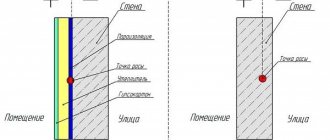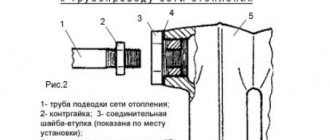A balcony or loggia in your apartment is priceless square meters that can be used usefully and not cluttered with unnecessary things. It’s good that many owners of this type of premises have understood how to properly manage non-residential space. But in the process of equipping a balcony or loggia for living space, one has to deal with a considerable number of misunderstandings and questions. I consider one of the most popular and exciting: “Is it possible to put the battery on the balcony?”
So is it possible or not to take the battery out onto the balcony?
In accordance with the Housing Code of the Russian Federation, Article 15, paragraph 5, a balcony or loggia does not belong to living space, and therefore reconstruction is prohibited here. At the same time, there are nuances that, with great effort, still make it possible to legalize the transfer of the battery to the balcony.
I said earlier in my blog that a balcony without heating will never become truly warm, and therefore using it as a living space will be almost impossible. Insulation and glazing with metal-plastic profiles serve as good thermal insulation, protecting the space from cold air entering inside and heat leakage to the outside. But to keep your balcony or loggia warm at any time of the year, you need to think about heating. At this stage of repair, many people are thinking about the heartbreaking question of whether it is possible to take the battery out onto the balcony.
Loggia heating

Many will agree with the statement that a heated balcony or loggia is pleasant and productive. If space allows, you can arrange flowers on a warm loggia and admire them in winter. Some combine a loggia with a kitchen, thereby expanding its space. You can also use the heated area to create another room - a study or a nursery. Families with children of different genders resort to this option especially often. However, heating a loggia is not a simple process, it is labor-intensive and entails financial expenses.

Why you can’t install the battery on the balcony
Why you can’t take the battery out onto the balcony, even if there is an emergency need:
- You can flood your neighbors on the floor below.
In winter, when the temperature outside drops below zero, there is a risk that the heating battery installed on the balcony may freeze and burst under high pressure. In Moscow, even after insulating a balcony or loggia, permission to move the battery is not issued. - Additional load on central heating.
If one or more elements are added to existing radiators, the water pressure will weaken and lead to cold radiators throughout the house. So you risk not only getting a fine for a battery on the balcony, but also conflicts with your neighbors. - Heating cost.
The cost of “utilities” for central heating in a house is calculated per square meter for everyone living in the house. Therefore, by connecting the battery to the balcony, the price of heating will increase for all residents of the apartment building. If discovered, they have every right to sue and are likely to win. Of course, this fact can be hidden, but living in constant fear that a deception will be revealed is a stressful and risky business. - Problems when selling an apartment.
When selling square meters, you are required to give the buyer a technical plan (technical passport), which, in addition to the layout, also indicates the thermal circuit that you changed when you decided to install the battery on the balcony. There are two options here - return everything as it was or seek legality for the removal.
Choosing a radiator
When the procedure for obtaining permission has been successfully completed, it is time to choose a room heating element that is suitable for the loggia.
All batteries are divided into 3 types:
- economy segment;
- middle class;
- premium
The main criteria for differences are cost, quality of materials and duration of operation.
Cast iron
The best and most durable metal of all times has been and remains cast iron. The shelf life of such radiators is more than 35 years. They are stronger than analogs made from other materials, but they weigh a lot. It is recommended to install it on the loggia only from the side of the house wall. The balcony can support no more than 600 kg of weight.

There is no need to additionally load it, because there is an installed double-glazed window, finishing, tiles on the floor (or other covering), and furniture. They look quite massive and the classic look does not always fit into a modern interior.
Aluminum
They weigh much less, are made in a modern design, and conduct heat well. The only negative: they can rust and deteriorate if the water they receive is of poor quality. Recommended for private homes where the source of water is known and autonomous.
Bimetal
Radiators of this type are most often used in apartment buildings. Bimetallic structures are compact and look laconic. They come in different sizes, conduct and release heat well. Ideal for a balcony or loggia due to its light weight and versatility in installation.
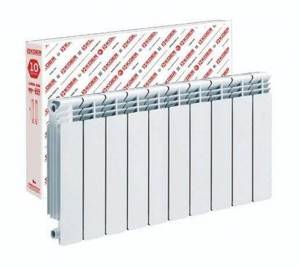
In what cases can it be legal to install a battery on a balcony?
In case of obtaining permission for redevelopment and the status of residential premises on a balcony or loggia.
It is possible to install a battery on the balcony without violating the legal framework, but with great effort and time. If you are ready for this, then I will tell you how to do it.
- To move a heating radiator to a balcony, you must obtain permission from the housing inspection. And it doesn’t matter whether you are taking out the old one or are going to install a new element in the heating system. If you begin to dismantle the radiator and install a new one without obtaining permission, you are already breaking the law. I would like to note that this procedure is a bureaucratic hassle that can last more than one month. If repairs are made, it will stretch, which is very unpleasant. Therefore, I often come across cases where they first install a radiator on a balcony, and then seek permission. But I want to note that there is a high probability that they may refuse to receive it.
- Before you go and ask for that very permission, take care to make accurate calculations. You must have accurate calculations on hand regarding the number and size of sections, their location, pressure in the pipeline and temperature. You can’t do this yourself without the proper skills, so you need to turn to professional designers. Such an extensive collection of information for the BTI will indicate the safety of your decision to place the radiator on the balcony, and therefore the likelihood of getting the go-ahead is higher.
- Before installing the battery on the balcony, it is necessary to make insulation. Without it, it is not advisable to carry out the transfer, since on a cold loggia all the warm air will go outside, and besides, in this case you will not be able to prove that the temperature on the balcony in winter will be acceptable for installing the battery.
Documents for obtaining permission:
- Calculation of thermal conductivity;
- An official conclusion from experts, which confirms that the water in the battery will not freeze;
- Developed planning project - you can contact the design company.
Depending on the region where you are going to install a heating radiator on the balcony, the housing inspection may modify and add an additional list of papers.
In order not to delay the repairs, some decide to install the battery on the balcony without obtaining the notorious permission, and only after the completion of the installation work begin to make the design. I warn you, this is risky, because there is always a possibility that BTI services may refuse a decision.
On the Internet and on various forums, I came across advice from owners of such apartments who decided that they could install a battery on the balcony without any paperwork. They say they live for 10 years and even manage to sell them. I want to assure you, firstly, not to listen to anonymous users who are not responsible for what is written (very sorry), and secondly, to approach your situation individually, because you will never know what and how others really had it . Perhaps their heating system is not central, but individual; the neighbors don’t mind or don’t care about what’s going on in others’ apartments; “The hour has not yet struck” and the discovery of an illegal layout remains a matter of time.
Think with your own head when reading such recommendations, and remember that if something happens, it is you who are responsible for what you have done, and not anonymous Internet users.
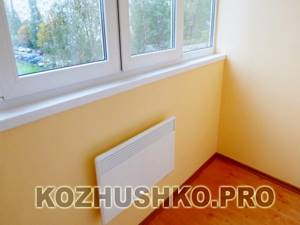
Possible connection diagrams
In the loggia, the battery can be connected in three ways:
- With jumper and tap. An excellent solution for this room, because all the heat will pass through the radiator without any loss;
- With jumper, but without tap. The presence of a jumper allows you to close the flow of hot water when the air in the room gets too hot;
- Without jumper, but with tap. The presence of such a solution allows not only to shut off the flow of water, but also to temporarily dismantle the radiator to carry out the necessary work.
Removing the battery allows you to make a full-fledged room in the loggia for permanent residence or solving any other problems. Of course, everything must be coordinated with the housing inspection and other regulatory authorities.
If permission has not been obtained from the authorities, then as an alternative option you can consider installing a heated floor system, which is also ideal for loggias and balconies.
If possible, it is best to entrust the work to professionals who are familiar with the features of installing heating radiators and putting them into operation.
What does the law say about removing heating radiators?
If, despite the fact that you have fulfilled all the requirements and there are no compelling reasons for refusal, you are still given a negative answer, be prepared to defend your position. And for this you need to have a good understanding of the bills that regulate this issue.
Study in detail these 2 laws of the Housing Code of the Russian Federation: Article 25, paragraph 1 and Article 15, paragraph 5.
Briefly about the essence of these resolutions:
Article 25, paragraph 1
“Types of reconstruction and redevelopment of premises in an apartment building” states that it is permitted to replace and relocate utility networks, which include heating. But there is a note that this condition applies to residential areas.
Article 15, paragraph 5
“Objects of housing rights” regulates the procedure for recognizing premises as residential. And therefore, it is important here to prove that the loggia or balcony, after redevelopment and integration with the living room, also became part of the living area.
Installation
work on installing, transferring and replacing batteries in the summer , when there is no water in the system. During the heating season, before carrying out work, you need to obtain permission to disconnect from the network from the service company (not free), and shut off the riser at strictly permitted times (which the neighbors will clearly not approve of).
Carrying out such work requires professional training and the availability of tools. Particular attention should be paid to sealing all connections - the reliability of the system will depend on this.
Basic rules and requirements
For good heat transfer, the following distances and conditions must be observed:
- from the top of the battery to the window sill at least 10 cm;
- from the bottom of the battery to the floor at least 12 cm;
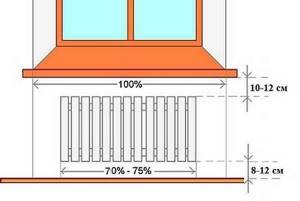
- at least 2 cm from the wall;
- the window sill should not block the radiator;
- the slope of the supply pipes should be 0.5 - 1 cm per linear meter;
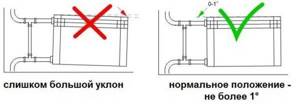
- the radiator must be located strictly in the vertical and horizontal planes - this is checked by a level;
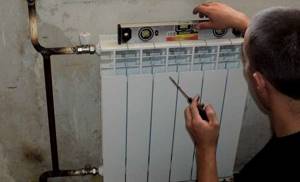
- you should try to avoid a large number of kinks in pipes, as this can lead to the formation of air locks and reduce the efficiency of the system;

- It is advisable to install a jumper with a tap - this will allow you to regulate the supply of coolant and the temperature in the room.
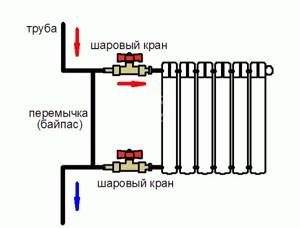
General requirements for installing radiators indoors:
Work order
- Remove the old indoor radiator. It is also necessary to cut the pipes at a distance of 10 cm from the connection points - if you decide on such a redevelopment, then it makes sense to replace the liner at the same time.
- Make holes in the wall or balcony partition through which the pipes connecting the radiator and the riser will pass.
- Pass threaded pipes through the holes so that they extend 8–10 cm into the room.
- Sequentially install all connecting elements (fittings, connections) from the side of the room. Parts of the required sizes must have threads.
- Mark the battery mounting location. Install and secure the brackets.
- Mount the battery, adjust the correct mounting using a level.
- Install jumpers, water inlet and outlet channels from the balcony. Install a Mayevsky valve for bleeding air.
- Connect to the general system and check the operation of the radiator.
When it comes to heating an attached loggia in an apartment building, in most cases it makes sense to consider other options: warm floors, ceiling infrared heating. Such systems are no less effective, and installation does not require approvals.
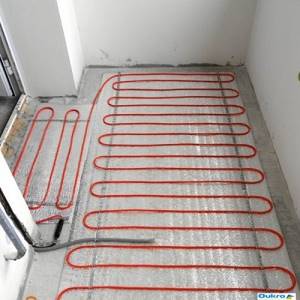
Electric underfloor heating cable system
Penalties and fines in 2021 for removing a battery
Illegal redevelopment carries with it penalties, and taking the radiator out onto the balcony and making the loggia part of the living space without permission is precisely an illegal action on your part.
If detected, the fine for illegal redevelopment, including for a battery on a balcony, in 2021 in Moscow and the region is:
For individuals – 2500 rubles;
For legal entities – 70,000 rubles.
Payment of a fine is not the only punishment. After this, you will be forced to return everything back. Therefore, in addition to the cost of the fine, you will also have to spend money on dismantling. At the same time, you can challenge the decision and file an application with the court with the provided evidence that such redevelopment with the radiator moving to the balcony does not pose a danger or any inconvenience to the residents of the house. To confirm this, it is necessary to collect the signatures of all neighbors. After this, the court makes a decision either on the legality of the repair or on dismantling.
Sequencing

So, the legal and technically correct sequence of actions if you want to place a heating radiator on the balcony consists of the following steps:
- insulation of external walls;
- coordination of redevelopment, obtaining relevant permits and conclusions;
- choosing the optimal type of radiator and installation method;
- wall preparation - installation of thermal insulation, finishing;
- direct installation.
If you are firm in your intentions, then for apartment buildings it is recommended to move the radiator from the room to the balcony, and not to install an additional one, which will immediately significantly reduce the efficiency of the general building system - this is unlikely to please the neighbors and will entail inspections.
Types of heating batteries for removal to the balcony
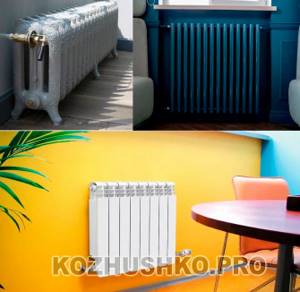
Once you have received everything you need to install radiators on the balcony, you need to select the type of device. True, if you are moving a battery that has already been installed against the wall of the balcony block, this issue is irrelevant for you.
Types of batteries and radiators are divided by class and materials of manufacture.
| Class | Materials for production |
| Economy | Cast iron, steel |
| Middle | Tubular steel, aluminum, bimetallic |
| Premium | Improved bimetallic, designer cast iron, cast aluminum |
In terms of performance characteristics, namely a long service life, cast iron battery models have. Their main drawback is that they heat up slowly. But at the same time, they cool slowly, prolonging the warmth in the room.
Steel batteries have a slightly shorter service life - 10-15 years. Steel radiators include tubular and panel radiators. The latter are in greatest demand. Steel ones will be more expensive, but the variety in shape and color allows them to be used for arranging designer balconies and loggias.
Aluminum batteries have an average service life of about 20 years. Light weight, compact dimensions (which is very important for installation on balconies) and variability of models have made them “favorites” among those who want to place the battery on the balcony. In addition, they also heat up quickly and have excellent heat transfer, which is also a positive indicator.
A good option for city apartments would be bimetallic options that are resistant to water hammer, inexpensive and have good heat transfer.
Which pipes to choose

For work, it is recommended to choose reinforced polypropylene pipes because they:
- easy to bend, allowing installation of any complexity;
- do not deform during operation;
- do not require welding - flux is applied to the joints and sealed with a special blowtorch;
- have a high heat transfer coefficient.
It is possible to use copper pipes, but this is a more expensive and difficult to install option. Ordinary propylene quickly deforms and loses its attractive appearance.
Installation and self-installation of a heating battery on the balcony
Studying what has already been written on this topic on the Internet, I found many articles that give some instructions for moving the battery to the balcony with your own hands. Such information content, on the one hand, benefits readers - after all, you don’t need to go anywhere and find out something, just take it and do it, as they say. But on the other hand, for some reason many do not take into account that this set of works is quite complex to perform and carries a lot of danger. One wrong step and you risk flooding the residents on the floor below.
Such work should be carried out exclusively by masters and specialists in this field. Even if you are not a “noob” at repairs, this does not mean that you can cope with connecting elements to a central heating system. The question is different - professionals absolutely refuse to carry out this kind of work if the customer does not have permits in hand. In fact, this is what encourages “home craftsmen” to do everything with their own hands. My recommendation is to still get permission, even before starting the repair, so that you don’t “stand idle” later, or, if you were not given permission, find an excellent alternative to moving the battery to the balcony - installing a heater.
We adhere to the letter of the Law
When removing the battery onto the balcony without completing the appropriate documentation, you need to understand that after this event you risk “running into trouble,” the most minimal of which will be the imposition of a fine on you.
Note: Currently, the fine for unauthorized transfer of heating equipment is 2,500 rubles for individuals and 70,000 rubles for enterprises.
But, in this case, the matter will not be limited to paying a fine. You will have to either dismantle the battery installed outside the apartment, or, having received written confirmation from all owners of the living space, prove in court that such a modification is safe for the heating system and does not affect the quality of life in the house of other residents.
Based on your application, the court will make an appropriate decision. He can authorize the changes you have made, after which they will be included in the Technical Plan of the apartment or recognize them as illegal. Then you will have to dismantle the installed equipment within the specified time frame.
If you doubt the need to move the radiator, we recommend that you familiarize yourself with an alternative heating option. Read how to make a warm floor on a balcony with your own hands on our website. The article discusses the features of all variants of this system.
It is also possible to use ceiling infrared heating on the balcony. It has a number of advantages and is much easier to install.
But no matter what option you choose, in any case, heating will only make sense if the room is well insulated. We told you how to do this correctly here.
Alternative solutions for heating balconies - heaters
When it comes to heaters on balconies, apartment owners are skeptical about this - they consume a lot of electricity, take a long time to heat up, and are ineffective.
This was the case 5 years ago, when basically you could only buy a fan heater, popularly called a “wind blower”. They really consumed a lot of electricity, and after they were turned off, the room cooled down again. With the advent of infrared heaters, the situation with heating on the balcony has changed significantly for the better. They quickly heat the room, consume little energy, are safe to use, they can be left on overnight, and when the required temperature is reached, the system automatically turns off the device. If, in addition to such a heater, you install a warm floor, you can spend time on your balcony in complete comfort. Regardless of the temperature outside the window.
I talk more about the types of heaters in this article.
If you still have questions or need help regarding heating your balcony, you can always contact me by phone, email, or through social networks. Best regards, Vladimir Kozhushko!
What to consider?
The idea of moving a heating radiator to the loggia is a good idea for creating a comfortable environment in this non-residential space during the cold season.
In this case, the following must be taken into account:
- To carry out such work, you must obtain permission. You can’t just take and dismantle the heating radiator in the room and install it in the loggia. It is also prohibited to add new elements to the apartment’s heating system without approval from the relevant authorities. At the same time, no one can guarantee that after contacting the housing inspection it will be possible to get a positive response from them regarding the transfer of the battery to the loggia - homeowners are not always given such permissions. In addition, this is a rather complex bureaucratic procedure that can last more than one month.
- Perform accurate calculations. All work must be performed professionally, therefore, calculations regarding the number of sections of the heating radiator in the loggia, its location, ambient temperature, and pressure in the pipeline must be entrusted to professionals. After all, adding a new battery is fraught with consequences for the apartment owners and their neighbors.
- Carrying out insulation work. Of course, there is no point in moving the battery into the loggia if high-quality glazing and insulation have not been done. All surfaces of the loggia must be insulated. Glazing – preferably two-chamber or three-chamber.
Heating options and their characteristics
Let's consider several alternative heating options.
Warm floor
Warm floors are one of the simplest and most elegant solutions when installing heating on a loggia. Warm floors are durable and practical. They heat the room with long-wave electromagnetic radiation, which has a beneficial effect on the human body. Due to the predominance of radiation heat exchange, the entire room is maintained at the same temperature, which corresponds to a greater level of thermal comfort.
The only drawback of heated floors is the price. And both installation and operation. On the loggia it is possible to install only floors with electric heating elements. It will not be possible to connect to centralized heating for the reasons already mentioned.
That is, you will have to spend money first on installation, and then regularly spend money on electricity.
Electric heaters
Electric heaters are less expensive in terms of electricity, but the heating elements of small heaters can become hot above the 90-degree mark, which creates the possibility of dust sublimation. Freeze-dried dust in the inhaled air increases the risk of cancer.
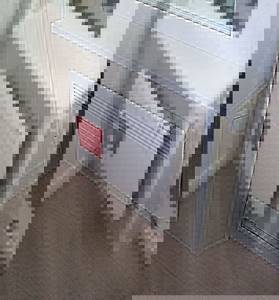
Electric heater on the loggia
In addition, electric heaters cannot heat the room evenly. The area that is closer to the heater will always be warmer than the upper areas of the room.
Oil radiators
Oil radiators are a kind of compromise between traditional heating and heated floors. There is an electrical connection from the heated floor here. Due to the electric heating element, the oil, which is the coolant, warms up and begins to circulate through the radiator.
Why not seal water inside? Yes, because water is more corrosive and has a lower heat capacity. In conventional systems, oil is too expensive to operate. Whereas in such small systems the use of oil is quite justified.
The temperature to which the oil radiator can be heated does not exceed 90 degrees, and the room warms up more evenly than when using electric heaters.
However, some disadvantages of conventional radiators still remain. Convective heat transfer, which predominates when using oil radiators, involves mixing layers of heated and cold air due to density differences. But this mixing also causes the movement of layers of dust, which is not very good for health.
In addition, convective heat exchange cannot provide uniform heating of the room to the same extent as radiation. And convection itself has a less favorable effect on the body.
Obvious advantages include noticeably lower energy consumption compared to underfloor heating and the ability to move the radiator around the apartment using wheels.
Convector heater
A convection heater is of the same nature as a conventional electric heater. The difference in the name is nothing more than just a marketing ploy
A large number of scientific concepts in the name attracts the attention of buyers. The operating principle and the devices themselves are no different from conventional electric heaters
Infrared heater
Infrared heaters warm the room using infrared rays. At the same time, energy costs are much less than the operation of heated floors. The device is a small radiator that is installed under the window and glows bright red.
This device uses mainly radiation heat transfer. This seems like an ideal replacement for heated floors. But no. These heaters are based on the use of short-wave radiation. Long-term exposure to short-wave radiation on humans is fraught with a whole range of unpleasant diseases. Yes, and constant light irritates some people, but heating systems should still be invisible.
To summarize, we can say that an ideal, but expensive option for heating a loggia is a warm floor. It meets all the requirements for heating systems. Of the analogues, only an oil radiator is worthy of attention; other systems are suitable in other situations, but specifically for a loggia and residential premises in general: they are not particularly suitable.
https://youtube.com/watch?v=rGjOsxiq3JQ
Theoretical part
The fact is that in order to sell/donate/transfer real estate, a certificate from an engineer from the city technical inventory bureau (BTI) is required.
Here is another important nuance: in the Housing Code of the Russian Federation there is Article 25, and in it - paragraph 1. It states that the transfer of utilities is the reconstruction of residential premises. But the loggia and balcony are not such. This means that it is impossible to move the radiator there, that is, it is prohibited. And, by the way, this is no coincidence. Here are a few reasons why things are the way they are and not otherwise:
- As a rule, water is supplied to the heating system through pumps. They, of course, have a certain power reserve, but if you add one or more additional units to the overall system, the pumps may not be able to cope. This will lead to a decrease in pressure in the pipes and, as a result, to a catastrophic decrease in heating efficiency;
- but let's assume that the pumps worked. But an additional battery will increase the area of heat distribution - specifically in your room. Therefore, the water in the pipes will cool too quickly. This means that the overall temperature in your apartment will drop by several degrees. I think this is not at all what you need;
- Due to unauthorized intervention in the heating system, air jams may form, since the amount of water will be calculated exactly for the number of units that were originally installed in the house. But air jams can lead not only to a lack of heat in your or other apartments, but also to a local accident;
- if the balcony/loggia is not sufficiently insulated in all planes (walls/floor/possibly ceiling), the temperature there may drop below 0° during the cold season. Then the pipes may simply burst. Then both your balcony and the balconies of your neighbors below will be generously filled with water. Not the most pleasant prospect, is it?
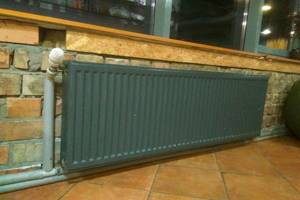
In essence, there are two ways to achieve the desired result: on your own and with an intermediary. Now we will look in more detail at what these decisions are, and then we will provide a list of necessary documents that will be useful to you in any case for approval.
Method 2. Settlement through an intermediary
When working through an intermediary, everything is much simpler: you provide a package of necessary documents, draw up an agreement for the provision of services, pay the amount specified in the agreement - and simply wait until the office does the work for you.
But be careful when choosing a company, as there is a high risk of ending up with an unscrupulous company. If possible, check her reputation. Find reviews about its work in other sources (the Internet can help), read reviews of people who have already used their services, check the year the company has been providing services. The older she is, the higher the likelihood that the matter will go well and you won’t be left hanging.
Finding such an office will not be difficult. Just enter in the Yandex or Google search bar the query “how to install heating on a balcony agency” or “how to legalize the transfer of a battery company.” You can add the name of your city to the request - Moscow/St. Petersburg/Arkhangelsk... The search engine will first of all give you several landing-pages of companies that are ready to help you. Moreover, with a focus specifically on your locality. But, again, don’t rush to contact the first one you come across. Analyze and compare several options, compare prices for services, and only then draw a conclusion.
Documentation

- A document confirming your right to an apartment (sale and purchase agreement, gift, inheritance/privatization certificate).
- Consent of residents who have reached the age of majority to remodel the living space. The document must be certified by a notary, but this can also be done in a housing maintenance office.
- Technical passport. In this case, the inventory period should not exceed one year.
- Sketch. In the event that the battery has already been removed - and you are making a settlement retroactively - you will need to take a photo of the fruits of your “amateur work”.
- Consent to carry out work from neighbors above.
- Passport and its copy.
- Identification code with a copy.


